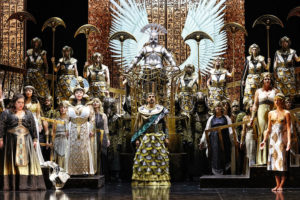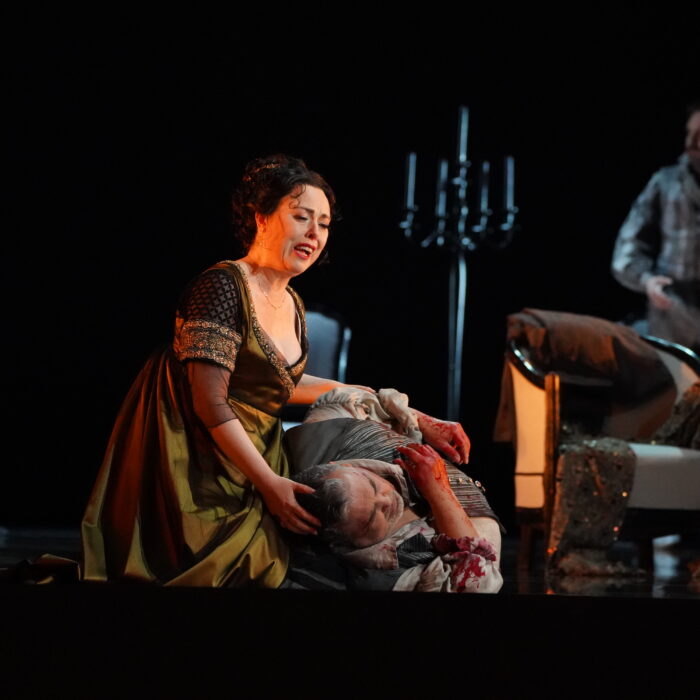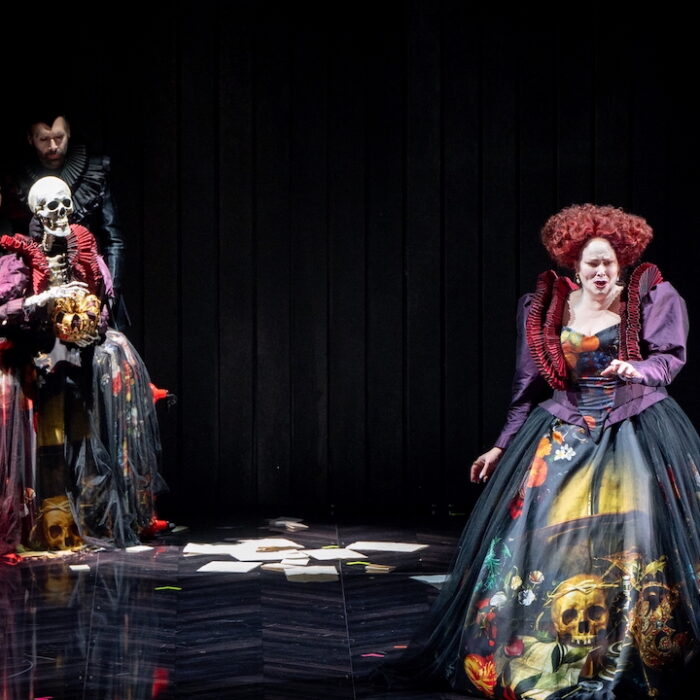
Opera Australia 2021 Review: Aida
Leah Crocetto Leads a Superb Revival of Davide Livermore’s Staging
By Gordon Williams(Photo: Prudence Upton)
The first of Opera Australia’s 2021 Sydney winter productions was a revival of the 2018 production of “Aida” originally directed by Davide Livermore. The work opened on Tuesday, June 22 at the Joan Sutherland Theatre of the Sydney Opera House after having been seen earlier in the year in Melbourne.
This premiere took place in the nick of time. Australia has been enjoying near-normal life for the better part of a year but, within days, Sydney – affected by an unexpected outbreak of the Delta strain of COVID-19 – went back into lockdown. You mightn’t suspect any interruption to normal life from the hordes of people converging on the city’s parks or hovering around cafés ordering takeout (the limited-service allowed), but indoor events are suspended for now.
And this production of “Aida” was effectively an indoor event.
Charles Osborne in his book “The Complete Operas of Verdi” says that “For all its public scenes, [“Aida”] is the most intimate of ‘grand’ operas…” It is not unlike, “La Traviata,” Opera Australia’s outdoor presentation on the Harbor back in April and May with its telling contrasts of interior and exterior drama. And yet, “Aida” is also the arena opera “par excellence” and perhaps, for some, overly familiar as such. How might it go down in the confined space of Sydney’s relatively compact Joan Sutherland Theatre?
The answer is superbly. Livermore’s production, restaged on this occasion by Shane Placentino, highlighted the fact that this opera is a very focused examination of an intense love triangle as well as one of Verdi’s most coherent fusions of the political with the personal. In this production, the highly-detailed portrayals of all three principals, American soprano Leah Crocetto as Aida, French-Russian mezzo-soprano Elena Gabouri as Amneris, and Turin-born tenor Stefano La Colla as Radamès, minutely conveyed the conflicts experienced by the main characters between personal love and love of their respective countries, Aida’s hostage Ethiopia and Amneris and Radamès’ Egypt.
Convincing Portrayals
“Two queens love the same man” is how you might sum up this opera on a poster – and both Crocetto and Gabouri invested their royal status with confident, convincing, wide-gamut performances. Their Act two duet “Fu la sorte dell’armi,” where Amneris tries to divine Aida’s feelings for Radamès, the captain of the Egyptian guard, first by telling her he is dead in battle and then telling her he is alive was full of intense musical argument. The hectoring tone as Amneris bullied her “slave” (even pulling Aida’s chin around to face her) contrasted with the poignancy of Crocetto’s imploring adagio “Pietà ti prenda del mio dolore.” Crocetto’s reprise of “Numi, pietà,…,” her prayer from Act one, came out ever-more beautifully and soaringly after all these vicissitudes.
There was admirable clarity to all of La Colla’s “front-of-stage” declamations. His signature aria, “Celeste Aida,” was lyrically direct and simple, giving appropriate weight to every word, and befitting a character whose initial expression of love is not yet complicated by competing motivations.
Daniel Sumegi (Ramfis), Warwick Fyfe (Amonasro), Gennadi Dubinsky (the Egyptian King), and Jane Ede (the High Priestess) etched out perfectly drawn supporting characters. Dean Bassett’s small role of the Messenger was a delight in the clarity with which he delivered his short but important information. The color-matching of voices, noticeable immediately in La Colla and Sumegi’s first scene dialogue, was another example of the narrative vividness of this production.
A Superb Revival
This was a production that clearly mapped status. Gennadi Dubinsky’s King, in Costume Designer Gianluca Falaschi’s head-to-toe armor (even his upper face was always concealed), was almost sinister (concealment confers power, perhaps) and Amonasro’s costume, almost street-clothes, suggested where our sympathies might lie. Of course, Amonasro doesn’t want the Egyptians to know they’ve captured the Ethiopian king, but the harsh white light with which Lighting Designer John Rayment captured the Egyptian King on entry somewhat enhanced the marmoreal/human associations.
“Ten towering digital screens create ever-changing floor-to-ceiling set pieces. Immersive digital video design ranges from rich symbolism to vivid landscapes” says the company’s advance publicity of this production, and this digital dimension by Digital Content Designer D-Wok, deepens the stage.
There was a bit of “having it both ways,” maybe, in the alternation of symbolic and realistic images. Why symbolic sometimes and realistic others? The blinking black panther that backed Amneris may not have been needed given Elena Gabouri’s predatory interpretation of Amneris but the more realistic images, such as the ripples of moon-silvered waters nicely complemented Verdi’s low-flute evocations of Nile nights. And there was something thrilling in the constant coming (a filmed loop) of a messenger hastening up a narrow gorge (the valley of Napata, presumably) during Act Two scene two. Considered against the pace of the Triumphal March the slow-motion gallop provided an exciting metric counterpoint.
Special mention must be given to Livermore’s choreography in this production, an integral part of the narrative even if ballet in this sort of opera derived from the French tradition of the divertissement. By turns sensuous and convulsive, hypnotic and murderous (martial art-like gestures seemed to be re-enacting the Egyptian vanquishing of their foes in the Triumphal scene), the ten women comprising Opera Australia’s Dancers enhanced this production’s atmosphere of formidable femininity.
Tellingly simple and even appropriately ritualistic was the blocking with, for example, Amneris often gaining the ‘upper-stage hand’ (if that can be a phrase) or Ramfis and his priests quizzing Radamès over his betrayal with backs to the audience then turning back around on his refusals to answer, successfully overcoming any risks to pitch and unison.
Credit goes to Italian conductor Lorenzo Passerini for his supervision of this large musical enterprise, but even more so for the brisk efficiency of his storytelling. Rest assured the sound was often gripping in the massed ensembles. The stage may have been on the small size but the compact mass of sound coming out into the auditorium and six fanfare trumpets in upper side balconies during the March, contributed in no small way to the production’s epic quality. Opera Australia’s Orchestra with too many fine players to list also perfectly conveyed the contrasting luxuriousness of desert nights.
This was a production that respected the sometimes-overlooked close-up focus of Verdi’s drama of intimate human relations. On the other hand, on a personal note, I took a friend – a cinema and theater-goer – who had never before been to the opera who was taken by the complete experience.
Later I asked her what she thought. “Amazing. I’ve never seen anything like it.”
“Based on last night, would you prefer to go to the opera or straight plays?”
“Definitely opera. Easier to get engrossed in.”
“Because of the music?”
“And the production values. I am aware I am watching a play. I don’t get lost in them.”
A reminder perhaps never to take this great art form – or a piece of standard repertoire like “Aida” – for granted.



